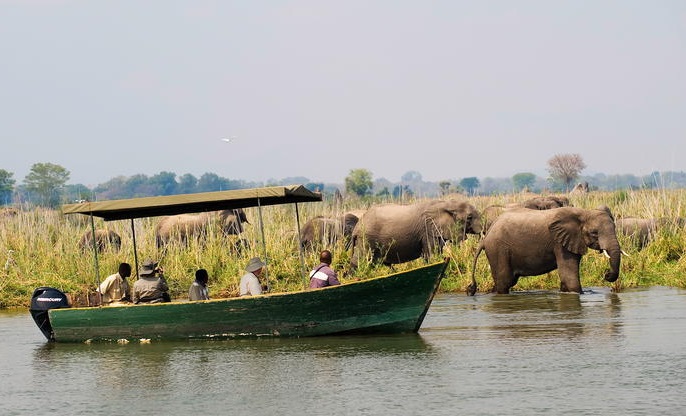Liwonde National Park Malawi
Discovering the Hidden Gem of Malawi: Liwonde National Park
Malawi, often referred to as “The Warm Heart of Africa,” is a country that exudes charm and friendliness, and its wildlife is as diverse as its people. Tucked away in the Southern region of this beautiful country lies a hidden gem that is a must-visit for nature lovers and adventure seekers alike: Liwonde National Park.
Established in 1973 and covering approximately 580 square kilometers, Liwonde National Park is a sanctuary for some of Africa’s most iconic wildlife. It offers a unique safari experience, away from the crowds of the more well-known African parks. Here, the Shire River, Malawi’s largest river, meanders through the park, providing life-sustaining waters to the wildlife and creating lush landscapes and diverse ecosystems.
LIWONDE NATIONAL PARK MAP

Wildlife in Liwonde National Park
Liwonde National Park is a haven for a rich variety of wildlife. It is home to one of the largest remaining elephant populations in the country, and these gentle giants can often be seen wandering the park’s savannahs. The park also offers sanctuary to endangered species like the black rhino, which has been reintroduced to the area thanks to conservation efforts. Visitors may also spot other mammals such as buffalo, hippos, crocodiles, and antelopes including the rare sable and kudu.
The park’s birdlife is spectacular, with over 400 species recorded. It is a paradise for birdwatchers, with specials such as the Pel’s fishing owl, Lilian’s lovebird, and the African skimmer often sighted. The park’s varied habitats, from woodlands to wetlands, make it one of the best birding destinations in Southern Africa.
Common Animals in Liwonde National Park
Buffalo
Hippos
Crocodiles
Elephants
Sable Antelopes
Greater Kudus
Black Rhinos
Common Birds in Liwonde National Park
African openbill
Black Heron
Bohm’s bee-eater
Long-toed lapwing
Pied Kingfisher
African Skimmer
Pel’s Fishing Owl
Liwonde National Park Safari Experience
One of the most unique aspects of Liwonde National Park is the variety of ways visitors can experience the wildlife. Unlike many other parks where game drives are the norm, Liwonde offers a more intimate encounter with nature.
Game Drives
For those looking to cover more ground, game drives provide an exhilarating way to traverse the park. Guided by experienced rangers, visitors can venture into the heart of Liwonde on morning or evening drives. The golden hours of dawn and dusk are when the park truly comes alive, and the cooler temperatures increase the likelihood of sighting predators on the move.

River Safaris
The Shire River is the lifeblood of the Liwonde national park, and a boat safari offers an excellent opportunity to observe wildlife from a different perspective. As you glide along the water, you can watch elephants bathing on the banks, hippos submerging beneath the surface, and crocodiles sunbathing on the river’s edge. It’s a peaceful and serene way to enjoy the park’s natural beauty.

Walking Safaris
For those who want an on-the-ground experience, walking safaris are available and are led by experienced guides. This is an immersive way to explore the bush, learn about the flora and fauna, and track animals on foot. It’s an exhilarating feeling to be out in the open, with nothing but the sounds of nature surrounding you.

Night Drives
Night drives provide a glimpse into the nocturnal life of the park. With the help of a spotlight, you can catch sight of elusive creatures that only come out after dark. It’s a chance to see predators on the prowl and witness the night-time activities of the park’s inhabitants.

Cycling Safaris
For a more active adventure, some lodges in Liwonde offer cycling safaris. These guided tours on mountain bikes allow you to cover more ground and experience the thrill of being in the bush while pedaling along the park’s tracks.
Liwonde National Park is not only a wildlife treasure but also a success story of conservation. The park is managed by African Parks in partnership with the Malawi Department of National Parks and Wildlife. Together, they have worked to combat poaching, reintroduce species, and manage habitats to ensure the park’s biodiversity thrives
Community involvement is also key to the park’s success. Local communities are engaged in conservation efforts, and the park provides employment opportunities, which helps to reduce human-wildlife conflict and ensures that the benefits of tourism are felt by the surrounding areas.
Planning Your Visit
Liwonde National Park is accessible by road and is approximately a four-hour drive from Lilongwe, Malawi’s capital, or a two-hour drive from Blantyre, the country’s commercial hub. There are also airstrips in the park for those who prefer to fly in.
Where to Stay
The park offers a range of accommodation options, from luxury lodges to eco-friendly campsites. Whether you’re looking for indulgence or a back-to-nature experience, there’s something to suit your preference. Lodges and camps often organize the activities mentioned earlier, making it convenient for visitors to plan their adventures.
Best Time to Visit
The dry season, from May to October, is the best time to visit Liwonde National Park. Wildlife is easier to spot as animals congregate around the Shire River and other water sources. The wet season, from November to April, transforms the park into a lush landscape, and while some tracks may be impassable, it’s a beautiful time for bird watching.
What to Bring
When packing for Liwonde, it’s essential to bring binoculars for wildlife and bird watching, a camera, comfortable walking shoes, light clothing for the daytime, and something warm for the cool evenings. Don’t forget to pack sunscreen, a hat, and insect repellent to protect against the sun and mosquitoes.
